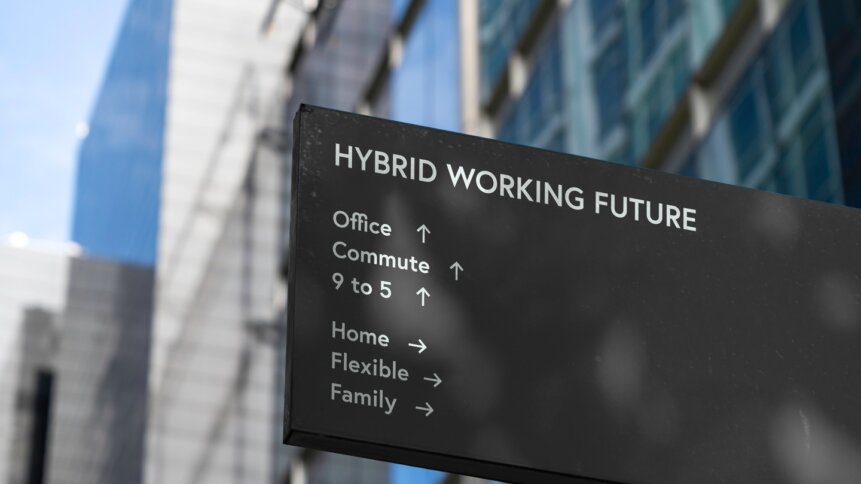What is hybrid working in 2023?

|
Getting your Trinity Audio player ready...
|
The meaning of hybrid working was changed – seemingly forever – by the events of the Covid-19 pandemic.
Before the virus, working from home was frequently a luxury add-on to a standard office-based role, not generally available, and frequently bought by a cut in basic pay.
When the pandemic arrived, and companies closed premises to minimize human contact though, governments around the world followed suit and essentially shut all but vital organizations down in their traditional three-dimensional form.
READ NEXT

Workplace trends in 2023
At almost any point in our history prior to now, that would have caused chaos, and most likely the collapse of entire economies.
The hybrid lifeline.
In those circumstances, the meaning of hybrid working was “lifeline” – allowing people to still earn a wage, and companies to avoid (in at least a healthy number of cases) imploding into non-existence through a lack of footfall.
That was then.
This is now.
What’s the meaning of hybrid working today?
Obviously, given the fact that it passed its most unlikely trial period during the pandemic, hybrid working – the ability to work from home, work remotely from any location with a strong, secure net connection, and/or work in an office as required – is here to stay.
If that sounds anodyne, it’s worth remembering that a few short years ago, that was by no means a given – and many firms continue to push for a return to full in-office working (Paging Mr. Musk…). But the practices of hybrid working have proved themselves more than equal to the task of keeping businesses running as normal, while also delivering the benefits of flexibility that allow real life – including family life – to take more of a front seat in the work-life balance equation.
Geographical flexibility.
That’s a lesson that we were sometimes harshly taught during the pandemic – that life should always be at least as important as work, and that hybrid working allows it to take that level of prominence, which the geography, the travel, and even to some extent the corporate culture of highly driven office-based companies sometimes made impossible in the pre-pandemic era.
So if we’re looking for the meaning of hybrid working in 2023, it’s fair to list “increased flexibility” as one of its core components.
With many staff now working mostly from home, it allows for most of real life to be significantly more foregrounded, while still delivering on work KPIs and contributing to the requirements of the daily, weekly, or project workload.
It’s also fair to say that hybrid working in 2023 means significantly greater geographical distribution of staff. LinkedIn is now filled with vacancies that say they’re either “Hybrid (within a City’s distance),” or simply “Hybrid (Period).” That second type of vacancy represents another significant core principle of hybrid working in 2023 – the ability for companies to cherry pick talent from a much wider pool than they might previously have found within daily commuting distance of their office.
While we have yet to see the full effect of that change, it could eventually lead to the shifting of businesses out of expensive and no longer necessary urban real estate, especially if we move to a more majority-hybrid or majority-remote working model.
What real estate currently exists is also being re-shaped by hybrid working practices, with many workplaces aiming to maximize the effectiveness of the time staff spend in a central office, focusing on collaborating and team-building when they convene in a three-dimensional space. That means a relative collapsing of cubicles and sealed-off offices, and a growth of more collaborative spaces.
But certainly in 2023, hybrid working has allowed that geographical diversification of teams and talents that was simply not feasible in a pre-hybrid age.
Temporal flexibility – death of the 9-5?
There’s also been a development of temporal flexibility as a direct result of hybrid working, too. As life takes up a more prominent role in the work-life balance, and as more people work more hours at home or remotely than in an office, it has led to companies – barring urgent deadlines – relaxing their approach to the strict 9-5 working hours of the pre-hybrid age.
Especially given the geographical diversification of teams, which can even involve people in different countries or time zones working collaboratively on projects, it has become a relative norm for some team members to work outside of the strict 9-5, which both frees them up to live their lives and take care of business in windows of time that are convenient to both themselves and their companies.
All of these things of course are driven by probably the most obvious characteristic of hybrid working – the increase in technology required to make the model work.
The pre-hybrid office was already fairly tech-heavy, with most work depending on computers, internet connections for the like of email and Teams, and specialized software that served the needs of particular teams – like Salesforce for sales teams, Hubspot for project management teams, and so on.
More hybrid technology.
But the technological needs of the hybrid working model involve a significant ramping up of those connections, as more and more businesses move their operating programs online, usually to a cloud, and remote workers connect directly to them through ideally secure networks. The increasing demand for cloud space, while it’s driven more by other factors, has certainly felt the impact of a shift from an office-based to a hybrid working model.
The rise in video conferencing tools – which saw both businesses and frequently families through the pandemic – has also demanded a higher level of technological involvement in most daily workflows, replacing bland text communication within teams with short, personal, video meetings that allow for significantly better team building and a reduction in redundant re-communication of details.
The very nature of hybrid working in 2023 has led to the development of a whole additional business efficiency software market, too.
These tools help to tighten the connectivity and monitoring function that would previously have been inherent in the collection of all team members in a particular building, and probably a particular part of that building. With staff working remotely, these software tools help to restore the balance of that lost proximity.
The cybersecurity ramp.
And finally, hybrid working in 2023 has evolved to include a heightened cybersecurity element. Again, when everyone worked in a single location – and only in that location – cybersecurity was easier to manage, particularly if the company still used on-prem data storage and servers.
When workers were forced to work from home and nowhere else, the cybersecurity requirement was relatively unchanged, because most home net connections now come with a degree of security.
But when lockdowns were lifted and hybrid workers could work from anywhere with a net connection, the statistics for cybersecurity concerns went relatively through the roof, forcing cyberinsurance companies to consider putting up premiums come renewal time.
That has forced companies to be significantly more aware of their responsibility to train staff – particularly remote staff – about good cybersecurity practice, especially when it comes to resisting malware and protecting connectivity to company systems, through common cyberhygiene practices like password protecting laptops and using VPN connections wherever possible when using public wifi.
The meaning of hybrid working.
The meaning of hybrid working in 2023 then has several significant components.
- Geographical flexibility – people can work from anywhere.
- Temporal flexibility – people can work appropriate hours to enhance their work-life balance.
- Diversified hiring and teams – companies can pick the best person for the job, not just the best person within a small geographical radius.
- Collaboration focus when teams gather in the office – rather than traveling to a central location and then holding video meetings.
- A significant shift of programs and systems to external storage – from internal servers to external clouds, for easier access by remote workers.
- The driving of a relatively new ecosystem of business productivity software tools – to take the place of productivity monitoring by proximity.
- The massive increase in the use of technology, from video conferencing to time management software – to tighten the slack introduced by remote working.
- And an increase in focus on cybersecurity and training – as more remote working leads to more potential points of vulnerability in a company’s systems.









